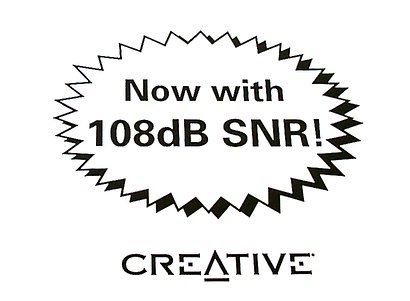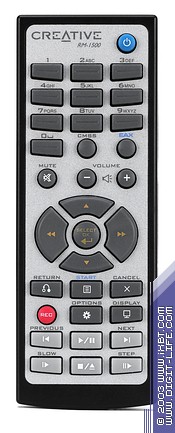A fabulous discovery
To shed light on this Creative bundled a piece of paper with explanations and a "108dB SNR" sticker.
"At the very last minute of development, we were able to improve the Signal-to-Noise Ratio of the sound card from 106dB to 108dB: Please ignore any references to 106dB SNR in the installation software or manuals as these elements were finalized before our breakthrough!"
Such a comment makes me doubt somehow that claimed specifications are real, especially considering the identical converters, other elements and circuitry. However, to prove it we should have re-measured these specs on at least Audio Precision System Two ($16000) that doesn't sound easy. Besides, we should have done this under the same conditions, as Creative's engineers had. But we'll get back to the measurements in general and the importance of this characteristic in particular later anyway.
Now let's talk about the remote control of Audigy2 ZS Platinum Pro external block in brief. It shrank by 1.5x in height and thickness to offer more comfort and layout logic.
Fighting the measurement illiteracy
Recently still more audio device manufacturers have been manipulating quality specs for marketing purposes. On the other hand, it's not that bad, as IT mass media alongside common users improve their knowledge and test sound parameters more often to check if they are as claimed. At the same time there's a large gap between marketing brochures and technical documents. Unfortunately for resourceful advertisers, for some reason in Russia there are evil and morose engineers instead of happy journalists. They make "malicious" measuring tests and stir up troubles by digging deep into products in general. So there's no reason to relax and sell another "long-anticipated audio revolution".
SNR: there's noise, but no signal
For example, let's take Creative's favourite marketing parameter (that pesters me already) — SNR (Signal-to-Noise Ratio). With the help of abstract logic and without any electronics knowledge you might suppose it would be the difference between signal and signal noise. The higher is SNR, the higher should be sound clarity and lower should be noise. So the new 24-bit formats alongside DVD-Audio are just bound to feature higher SNR. This consumer opinion provides foundation for the entire ideology of making this parameter a motto.
At www.soundblaster.com you can read: "Sound Blaster Audigy 2 ZS delivers 24-bit ADVANCED HD audio quality playback with incredible 108dB SNR." On the back of Audigy2 ZS box you can see: "Sound Blaster Audigy 2 ZS series is the only available PC platform to deliver Advanced Resolution playback at 24-bit/192 kHz in stereo or 24-bit/96kHz in 5.1 surround at 108dB SNR".
Now let's turn to the well-known technical brief "Personal Computer Audio Quality Measurements" By Dr. Steven Harris & Clif Sanchez Cirrus Logic, Crystal Audio Division (458Kb) written by the Audigy2/Audigy2 ZS DAC maker:
The label SNR should not be used due to industry confusion over the exact definition.
As you can see, SNR is not recommended for use at all as confusing! In case of Creative, SNR stands for noise when there's no signal. But this can't improve playback anyhow! Considering that CS4382 features auto-mute that completely disables DAC output after 8192 zero samples are received (about 0.2s in the 44100Hz mode). Therefore the DR (Dynamic Range) is developed and used instead of the SNR:
"Dynamic Range is the ratio of the full scale signal level to the RMS noise floor, in the presence of signal, expressed in dB FS. This specification is given as an absolute number and is sometimes referred to as Signal-to-Noise Ratio (SNR) in the presence of a signal. <...> DR can be measured using the THD+N measurement with a -60 dB FS signal. This low amplitude is small enough to minimize any large signal non-linearity, but large enough to ensure that the system under test is being exercised."
In our RMAA test we don't use SNR as well, following the recommendation above. However except for DR we also measure the Noise level by inputting minimal possible noise to the DAC that corresponds to the theoretically possible quantization noise at the given bit depth within the measured frequency range. Besides, it's often enough to disable auto-mute.
SpectraLABbers
Some sparse periodicals ignore RMAA for their love to everything alternative. They use pirate versions of SpectraLAB, in which SNR means THD+N expressed in dB instead of %. These enthusiasts measure SNR on a 1kHz sinusoid curve thus doing the double measurement work — harmonic distortions (hardly related to noise level (given they know meaning of those "wise terms")). And the A-weighing is naturally disabled. You can have some fun by emailing them this formula "their SNR" = 20 log ("their THD+N" / 100) — a universal conversion from % to dB.
A-shortweighing
And another thing: in measurements Creative uses the special AES17 filter that filters frequencies over 20kHz and A-weighs the result. This is entirely right for adopting the results to the average human ear sensitivity:
"Example measurement result could be listed as DR = 85 dB FS A This example indicates that the dynamic range for the playback path is 85 dB relative to a Line Out full-scale value (FS). The "A" suffix indicates that an A-weighting filter was used in this measurement."
However this is written in the smallest font in the specifications section, while there's "occasionally" no "A" suffix near the 108dB label. (By the way, the weighing curve isn't that simple as well. There are several variants that differ by curve intersection and zero point. This naturally provides slightly different results on different equipment and software, so it's better to conduct measurements under the same conditions.)
We know what DSPs are for! SRC and noise shaping
However it's not only us that stress manufacturers — they stress us as well :) Last time, when the Audigy2 was released, their special SRC (sample rate conversion) algorithm in DSP was overloading the digital path in RMAA IMD on 19kHz and 20kHz test signal, resulting in digit array and unfeasible improbably high distortions. We've fixed it in RMAA 5.1 by replacing CCIF with SMPTE sinusoid set in the IMD test (and also found out it handles audible frequencies more adequately.)
This time Creative implemented the AES17 filter to cut off frequencies over 20kHz, but didn't announce it aloud and took us by surprise a bit.
Result analysis indicated that in high frequency resolutions Creative utilizes the special dithering type — noise shaping — that amassed quantization noises in the high-frequency range thus clearing the audible range. So after we examined inadequate test results (when the noise made -53dB in the 24-bit/192kHz mode without filtering!), we had to release the special RMAA version 5.2 capable of filter emulation. At that our method provides higher methodical accuracy, as only limited FFT points are considered (without analog filters side effects) at spectrum expansion and the following noise RMS calculation.
The vulnerability of such "corrected" measurements is that they characterize "device-AES17 filter" chain more than the audio device itself. But there will be no such filter in real life, or rather it will be replaced by the amplifier-speaker-ear chain.
Besides, there's another thing. The forced noise shaping of the card naturally negates the noise shaping recorded at DVD-Audio at mastering. By the way, we haven't measured card parameters at DVD-Audio playback. It might be so that the signal rounds or can be sent round "too smart" DSP algorithms for drawing out that useless marketing SNR out of the hardware.
Write a comment below. No registration needed!



